There are more than 80 recorded ways to wear a sari. The most common style is for the sari to be wrapped around the waist, with the loose end of the drape to be worn over the shoulder, baring the midriff. Here’s the first part of the erudite article. However, the sari can be draped in several different styles, says, fashionista Shameena, in the weekly column, exclusively for Different Truths.
Change is the only constant, and it couldn’t be truer than in the case of fashion trends. However, one trend that has held its ground through centuries is the classic sari. A garment that is a true reflection of a woman’s elegance and timelessness, India is a treasure trove of different saree varieties. And that’s not all, each region has a unique sari draping style as well. Each state boasts of multiple ways the sari can be draped keeping in sync with the needs of the women there. Hence, there is a wide spectrum of styles that women from all strata of the society.
Origin and History
In the history of Indian clothing, the sari is traced back to the Indus Valley Civilisation, which flourished during 2800–1800 BC around the north-western part of the Indian subcontinent. Cotton was first cultivated and woven in Indian subcontinent around 5th millennium BC. Dyes used during this period are still in use, particularly indigo, lac, red madder, and turmeric.
The sari evolved from a three-piece ensemble comprising the Antriya, the lower garment; the Uttariya, a veil worn over the shoulder or the head; and the Stanapatta, a chest band. This complete three-piece dress was known as Poshak, generic term for a costume. Ancient Antriya closely resembled dhoti wrap in the ‘fishtail’ version, which was passed through legs, covered the legs loosely and then flowed into long, decorative pleats at front of the legs. It further evolved into Bhairnivasani skirt, today known as ghagra and lehenga.
Uttariya was a shawl-like veil worn over the shoulder or head, it evolved into what is known as dupatta and ghoongat, today. Likewise, Stanapatta evolved into choli by 1st century A.D. Between 2nd century B.C to 1st century A.D, Antariya and Uttariya were merged to form a single garment known as sari mentioned in Pali literature, which served the purpose of two garments in one-piece.
Styles of Sari Draping
There are more than 80 recorded ways to wear a sari. The most common style is for the sari to be wrapped around the waist, with the loose end of the drape to be worn over the shoulder, baring the midriff. However, the sari can be draped in several different styles, though some styles do require a sari of a particular length or form.
Athpourey Sari from Bengal
One of the most recognisable saree draping styles is the Bengali style. In Bengal and Odia style, the sari is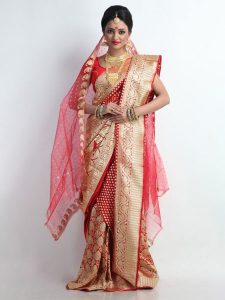 worn without any pleats. Traditionally, the Bengali style is worn without pleats where the sari is wrapped around in an anti-clockwise direction around the waist and then a second time from the other direction. The loose end is a lot longer and that goes around the body over the left shoulder. There is enough cloth left to cover the head as well. Traditionally, a bunch of keys was attached to the pallu thrown over the right shoulder. This signified the most important woman in the household as it is a great matter of pride to be given the reigns of the entire house.
worn without any pleats. Traditionally, the Bengali style is worn without pleats where the sari is wrapped around in an anti-clockwise direction around the waist and then a second time from the other direction. The loose end is a lot longer and that goes around the body over the left shoulder. There is enough cloth left to cover the head as well. Traditionally, a bunch of keys was attached to the pallu thrown over the right shoulder. This signified the most important woman in the household as it is a great matter of pride to be given the reigns of the entire house.
The modern style of wearing a saree originates from the Tagore family. Jnanadanandini Devi, the wife of Rabindranath Tagore’s elder brother Satyendranath, came up with a different way to wear the sari after her stay in Bombay. This required a chemise or jacket (old name for a blouse) and petticoat to be worn under the sari and made it possible for women to come out of the secluded women’s quarters in this attire.
Nivi Drape from Andhra Pradesh
Modern-day sari drape is derived from the Nivi drape of Andhra Pradesh, where the pleats are passed through the legs and tucked into the waist at the back. This allows free movement while covering the 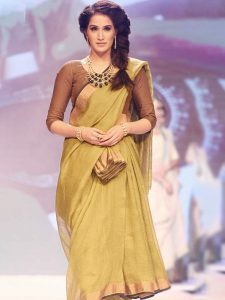 legs. This style was mostly worn by the aristocracy. Though not very work friendly, this style accentuates a woman’s curves in the best way and looks extremely regal. Most modern-day sari styles are derivatives of the Nivi style.
legs. This style was mostly worn by the aristocracy. Though not very work friendly, this style accentuates a woman’s curves in the best way and looks extremely regal. Most modern-day sari styles are derivatives of the Nivi style.
There are many traditional as well as contemporary variants of the Nivi style sari that are prevalent in India. Among these though, there are a couple that is especially commonly seen as regional variants.
Kaccha Nivi: The pleats of this type of Nivi sari is passed between the legs and tucked in at the back, giving the saree the appearance of a dhoti. The legs are covered and still allow for free movement.
Seedha Pallu: The Seedha Pallu or Gujarati style is a variety of the Nivi style which involves tucking the pleats in as the regular Nivi style, while the loose end is taken around the back and brought over the right shoulder. One of the shorter ends is taken around and fastened at the back.
Kappulu from Andhra Pradesh
Worn by the older women of the Kappulu caste today, this drape is undoubtedly very elegant. 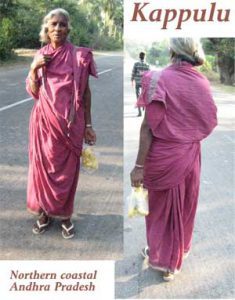 Interestingly, this sari is wrapped from the left to right unlike other forms of sari which are tied from right to left. This graceful sari drape features pleats in the back and the pallu passed is twice around the body and arranged in lovely pleated arcs.
Interestingly, this sari is wrapped from the left to right unlike other forms of sari which are tied from right to left. This graceful sari drape features pleats in the back and the pallu passed is twice around the body and arranged in lovely pleated arcs.
The Kappulu style aptly flatters a woman’s curves and the longer the saree, the better it looks. It has two stand-out features — one is the narrow pleats at the back which flatter the form and second are the two cascades of cloth formed by twisting the end piece twice around the body. The pallu is thrown over the right shoulder and can hang loose or be pulled to cover both the shoulders or wrapped around the neck as per convenience.
Mekhela Chador from Assam
One of the most elegant ways to wear an Assam handloom saree, the Mekhela Chador is worn by the petite beauties of Assam.
There are two main pieces of cloth that are draped around the body.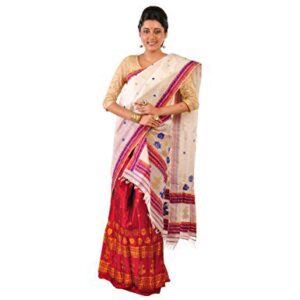
The bottom portion, draped from the waist downwards, is called the mekhela (Assamese: মেখেলা). It is in the form of a Sarong, a very wide cylinder of cloth that is folded into pleats to fit around the waist and tucked in. The folds are to the right, as opposed to the pleats in the Nivi style of the sari, which are folded to the left. Strings are never used to tie the Mekhela around the waist, though an underskirt with a string is often used.
The top portion of the two-piece dress, called the Chador, is a long length of cloth that has one end tucked into the upper portion of the mekhela and the rest draped over and around the rest of the body. Unlike the pavadai dhavani, the chador is tucked in triangular folds. A fitted blouse is often worn, though in the past another garment called a Riha was worn. A Riha is still worn as part of the Assamese bridal trousseau but over a fitted blouse.
Nauvari Sari from Maharashtra
The Nauvari or the original nine-yard saree speaks volumes about the strong, independent women of Maharashtra. Nauvari (also known as Nav Vari, Nauvaree, Kasta Sari, Kacha, Sakachcha, and Lugade) is a nine yards’ sari worn by the Marathi women or women of Maharashtra. The name ‘Nauvari’ or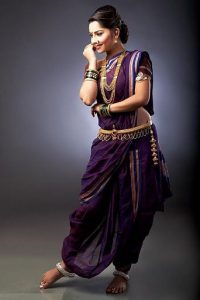 iginated from the saree’s length of nine yards. The style of drape for Nauvari has evolved drastically from the traditional style to the modern-age cult and is draped in such a way that it gives a trouser-dress like an appearance, while the sari is tucked at the back. Nauvari saris usually come in cotton and are worn without a petticoat, majorly by the Maharashtrian Brahmin women community.
iginated from the saree’s length of nine yards. The style of drape for Nauvari has evolved drastically from the traditional style to the modern-age cult and is draped in such a way that it gives a trouser-dress like an appearance, while the sari is tucked at the back. Nauvari saris usually come in cotton and are worn without a petticoat, majorly by the Maharashtrian Brahmin women community.
Historically, the women of the Maratha Empire showcased their abilities and caliber by assisting their fellow male warriors during the times of war. Hence, in order to accomplish their mission and yet maintain their comfort of physical movement during the wars, these Marathi women invented this Maharashtrian style of drape.
The traditional style of drape inspired by the warrior Marathi women is worn without a petticoat. The drape comprises following steps:
- Centre of the sari is neatly placed at the back of the waist.
- Ends of the sari are tied in the front, and then the two ends are wrapped around the legs, giving a trouser-like look.
- The decorative ends of the sari are then draped over the shoulder and the upper body.
The draping of this sari does not end here and moves down south to Goa, the land of fishermen and beaches. The traditional clothing of the fisher-women of Goa is an innovation to the Nauvari Sari –Pano Bhaju. The women wear this in bright and vibrant colours and team it up with Vakal, which is a string of beads with leaf loincloths worn around the neck.
The Koli community comprises people who migrated from Rajasthan, Himachal Pradesh, Gujarat, Maharashtra, Uttar Pradesh and Haryana, to the state of Maharashtra. The women of this community wear Nauvari in two pieces. The Koli drape involves the following steps:
- Nauvari is cut into two pieces.
- One piece is tied around the waist.
- The second piece is tucked at the upper part of the body, and pulled over the head via the left shoulder, to give a Marathi look.
(To be continued)
©Shameena Abdurahiman
Photos from the Internet, sourced from the author
#UttarPradesh #Haryana #Maharashtra #Sari #Gujarat #HimachalPradesh #KoliDrape #NauvariSari #Goa #MekhelaChador #Assam #KacchaNivi #SidhaPallu #AthpoureySari #Bengal #Kappulu #Chemise #FashionFunda #StyleOfSari #DrapingASari #DifferentSariDraping #DifferentTruths

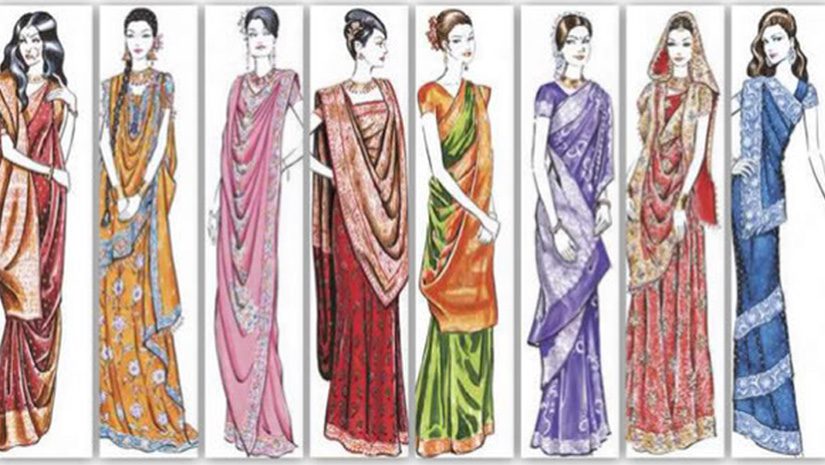
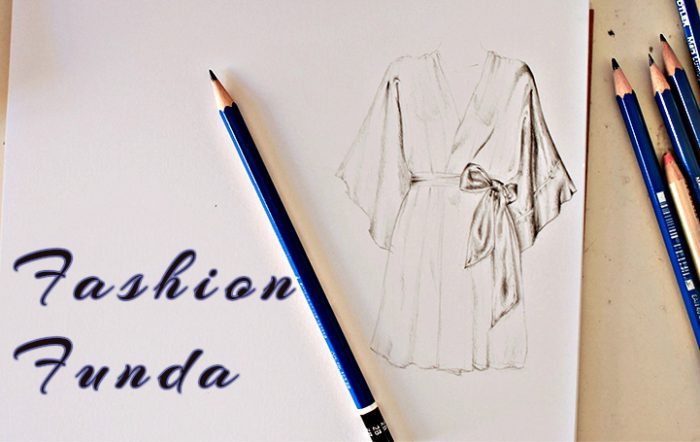
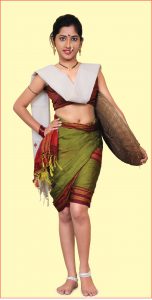



 By
By

